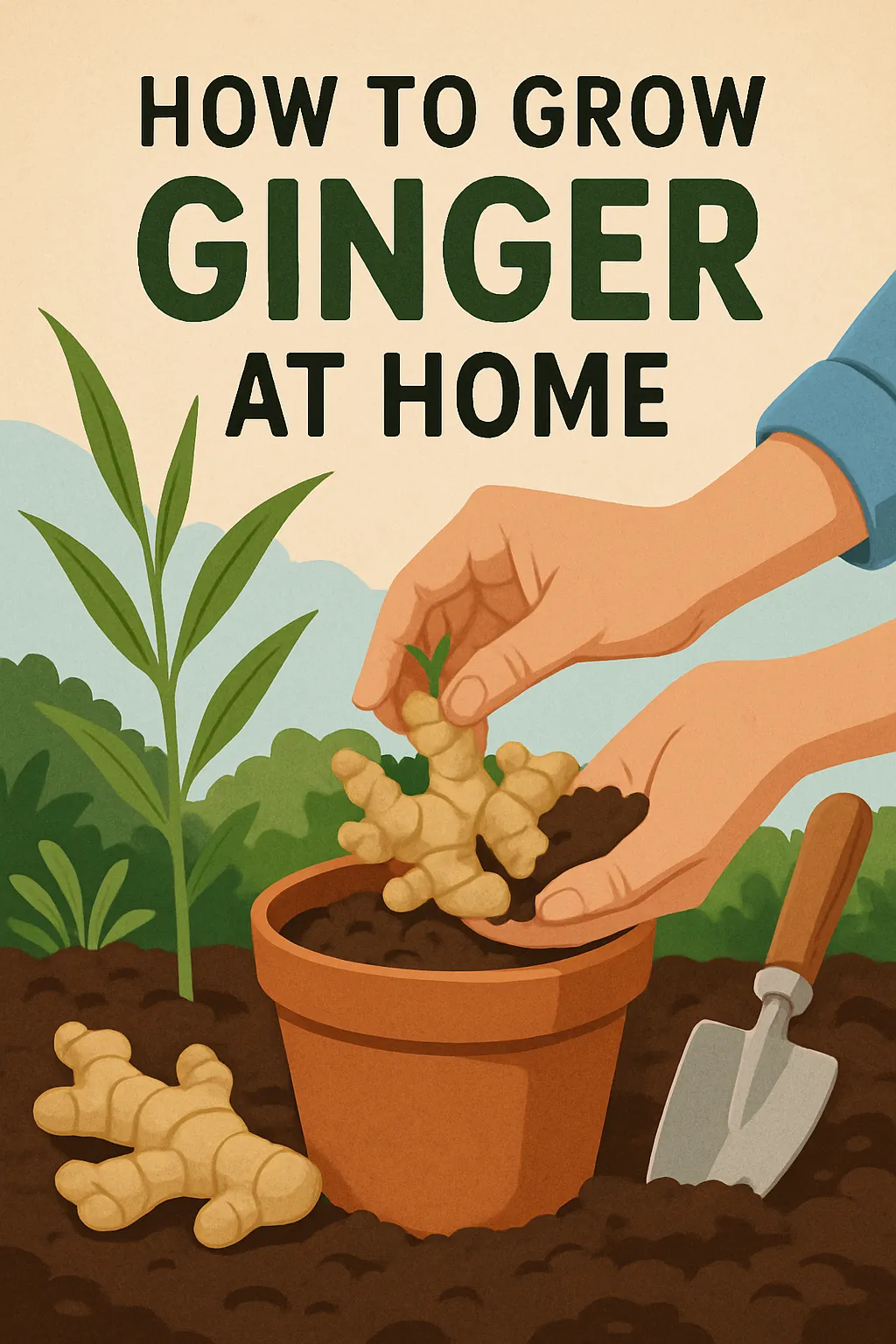Do you want to learn how to plant ginger root at home and enjoy a big harvest? I will guide you through simple steps to grow fresh, flavorful ginger right in your own space.

Growing ginger at home is simple and rewarding. It lets you turn a store-bought root into a continuous supply of fresh, spicy rhizomes. Watching your ginger sprout and grow is a satisfying experience.
Why Grow Ginger?
Many think of ginger as just an ingredient from the grocery store. However, beneath its skin lies a plant with a thick, underground stem called a rhizome. This rhizome spreads horizontally underground and produces new shoots and roots.
Growing your own ginger means you avoid the growth inhibitors often used in commercial rhizomes. You get fresh, organic ginger packed with flavor and health benefits.
How to Choose the Right Ginger Rhizome
Select high-quality ginger for planting. Look for:
- Firm, plump rhizomes that feel heavy for their size.
- No soft spots or shriveling, which can indicate aging or disease.
- Visible “eyes” or small bumps. These are sprouting points.
Avoid pieces with mold, rot, or fuzzy patches. Organic ginger bought from health food stores or farmers markets is best. If your ginger doesn’t sprout within two weeks of soaking, discard it and try again.
Preparing Ginger for Planting
To help your ginger sprout faster:
- Soak it overnight in warm water.
- Place it on a damp paper towel in a warm, humid spot.
- Watch for swelling and green tips within 7–14 days.
Once you see sprouting, it is ready to plant.
Ideal Growing Conditions
Ginger thrives in warm weather. Keep these conditions in mind:
- Temperature: stay above 70°F (21°C) daily.
- Indoor planting: do so in March or April after the last frost.
- Outdoor planting: wait until the soil is warm and stable.
Soil and Light
- Soil: rich, loose, and drains well. Use earthy, crumbly soil.
- Light: prefers partial sun or filtered shade. Too much direct sun can scorch leaves.
Use a soil thermometer to check soil temperature before planting.
Growing Containers
Choose a wide, shallow pot—12 to 18 inches deep and 15 to 24 inches across. Using fabric grow bags provides good drainage and airflow.
Making the Perfect Soil Mix
Create a soil mixture using:
- 1 part loamy soil
- 1 part compost or well-rotted manure
- 1 part coconut coir or peat moss
- A handful of perlite or coarse sand
Keep the soil pH between 5.5 and 6.5 for optimal growth.
Planting the Ginger Rhizome
Follow these steps:
- Cut ginger into 1-2 inch pieces, each with at least one eye.
- Dig holes 2–4 inches deep and space the pieces 6–8 inches apart.
- Place each piece horizontally with eyes facing up.
- Cover lightly with soil.
- Water thoroughly after planting.
- Cover with a 2-inch mulch layer to keep moisture in.
It may take a few weeks for shoots to appear. Patience is key.
How Ginger Grows
- Months 1-2: Roots develop; shoots stay underground.
- Months 3-4: Small green leaves emerge.
- Months 5-6: Rhizomes start to thicken and grow.
- Months 7-9: You can harvest or let it grow for more mature roots.
Check soil moisture regularly. Ginger prefers moist but not waterlogged soil.
Care Tips for Growing Ginger
Watering
- Water deeply when the top inch of soil dries out.
- Reduce watering as you approach harvest time.
- Avoid puddles to prevent root rot.
Fertilizing
- Use organic fertilizers like fish emulsion or compost tea every 3–4 weeks.
- Apply slow-release organic fertilizers during mid-season.
- Mulch monthly to add nutrients and help retain moisture.
Pest Control
Watch for pests like aphids or spider mites. Use neem oil if necessary.
Harvesting Ginger
- Signs: Yellowing leaves and stems falling over.
- Tools: Garden fork, pruners, soft brush.
- Carefully loosen soil and lift the plant.
- Remove soil gently and trim stems.
Post-Harvest Care
- Cure ginger in a warm, shaded place for 3–5 days.
- Store fresh ginger in the fridge or freeze it.
- Dry slices for tea or medicinal uses.
- Save the largest rhizomes for next planting season.
Common Mistakes to Avoid
- Planting unsprouted rhizomes.
- Exposing ginger to intense sunlight.
- Overwatering, which can cause rot.
- Starting to grow ginger in cold weather.
Growing Ginger Indoors All Year
Ginger can grow indoors if you provide proper conditions:
- Use a wide, shallow container.
- Keep temperature above 70°F.
- Maintain high humidity around the plant.
- Place near a sunny window or under grow lights.
Rotate the pot every few days for even growth.
The Benefits of Growing Ginger at Home
Harvesting your own ginger enhances your meals and health. It encourages mindful tending to a living plant. Sharing fresh ginger feels especially rewarding.
Growing ginger is about patience and connection. It offers a simple way to bring a tropical touch inside your home.
Start with a small piece today. Plant it in a warm, sunny spot and wait. Your garden will reward you with fragrant, spicy rhizomes for months to come.